![]()
![]()
![]()
Use LEFT and RIGHT arrow keys to navigate between flashcards;
Use UP and DOWN arrow keys to flip the card;
H to show hint;
A reads text to speech;
13 Cards in this Set
- Front
- Back
- 3rd side (hint)
|
Nutrition |
Process of providing/obtaining food for health and growth |
|
|
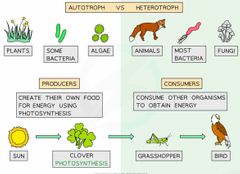
Nutrition in plants |
Plants use sunlight, carbon dioxide and water to produce oxygen and glucose in the process of photosynthesis plants create their own food for energy, they are described as being autotrophic |
Autotroph comes from: 'auto' = 'self' 'trophic' = 'feeding' |
|
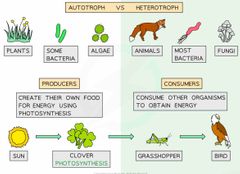
Nutritions in animals |
Animals consume other living organisms to obtain the energy they require They break down larger complex molecules into simpler molecules through the process of digestion As animals obtain their food from a different sources, they are described as being heterotrophic |
Heterotroph comes from: 'hetero' = 'different' 'trophic' = 'feeding' |
|
|
Repiration |
a chemical reaction carried out in all living organisms |

|
|
|
Excretion |
The removal of toxic materials and substances from organisms |
|
|
|
Excretion in animal |
Carbon dioxide from respiration Water from respiration and other chemical reactions Urea which contains nitrogen resulting from the breakdown of proteins |
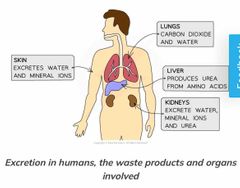
|
|

Excretion in plants |
Oxygen from photosynthesis Carbon dioxide from respiration Water from respiration and other chemical reactions |
|
|

Sensitivity responses in animals |
In humans, the nervous system provides a complex system of receptors, neurones and effectors that detect and respond to different stimuli using electrical impulses The endocrine system also allows a response to stimuli using chemical messengers, which travel in the blood, called hormones |
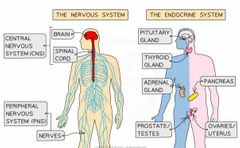
|
|

Sensitivity responses in plants |
plants, responses are controlled by chemicals and are usually much slower Geotropism describes a plants response to gravity which causes the roots to grow down into the soil Phototropism describes a plant's response to light which causes shoots to grow towards sunlight |
|
|
|
Movement |
Movement: action by an organism causing a change of position or place The movement of an organism from place to place is called locomotion Plants cannot move from place to place but can change their orientation |
|
|
|
Control |
Living organisms must control their internal environment in order to keep conditions within required limits. This is called homeostasis |
|
|
|
Homeostasis in humans |
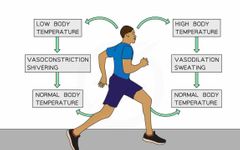
Thermoregulation: control of body temperature. The optimum human body temperature is 37°C If body temperature increases e.g. during exercise, mechanisms for control will be initiated to return the temperature back to the optimum Mechanisms include sweating or vasodilation Other homeostatic mechanisms in humans include glucoregulation (control of blood glucose levels) and osmoregulation (control of water levels) |
|
|
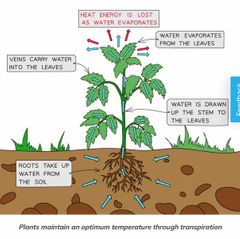
Homeostasis in plants |
Plants use transpiration to maintain a suitable temperature Water evaporates from the stomata on the underside of the leaf, leading to heat loss |
|

